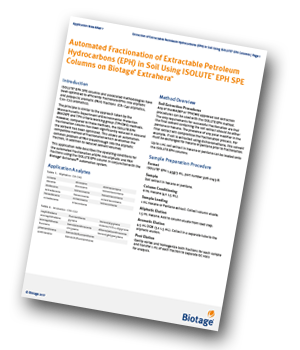Biotage has produced an application note describing the operating conditions for the automated fractionation of EPH into aliphatic and PAH fractions using the ISOLUTE EPH column in conjunction with the Biotage® ExtraheraTM automation system.
 Introduction
Introduction
The principle is similar to the approach taken by the Massachusetts Department of Environmental Protection (MADEP) and TPH criteria working group (TPHCWG) methods. However, compared to these methods, the ISOLUTE EPH fractionation column has been significantly reduced in size and the sorbent has been optimized. This allows an automation compatible method of fractionation, which overcomes the common problem of PAH breakthrough into the aliphatic fraction, in addition to reduced solvent volumes.
Method Overview
Soil Extraction Procedures
Any of the MADEP or TPHCWG approved soil extraction procedures can be used with the ISOLUTE EPH method. The only requirements for successful fractionation are that the final solvent containing the soil extract should be either pentane or hexane. The presence of any polar modifier in the final extract will compromise the fractionation process. For example, if soil is extracted using dichloromethane, this solvent must be exchanged for hexane or pentane prior to fractionation. Up to 1 mL soil extract in hexane or pentane can be loaded onto the ISOLUTE EPH columns.
Details of the sample preparation procedure, GC and MS conditions and SIM parameters can be found in the application note.
Results
The optimized ISOLUTE® EPH protocol on Biotage® ExtraheraTM provided typical recoveries as demonstrated in Figures 1 and 2 within the application note, with RSD values <10% for all analytes. The ISOLUTE® EPH columns are shown to allow a significant reduction in solvent consumption compared to the existing MADEP or TPHCWG procedures.




